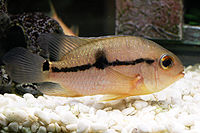Saddle Cichlid (Aequidens tetramerus)
From The Aquarium Wiki
Saddle Cichlid
Aequidens tetramerus
284 Litres (75 US G.)
20.3-25.4cm (8-10 ")
Freshwater
4.9 - 7.5
24 -26 °C (75.2-78.8°F)
1-13 °d
1:1 M:F
5-8 years
Family
Cichlidae
Contents
Additional names
- Saddle Cichlid, Two-Spot Acara
Additional scientific names
- Acara dimerus, Acara tetramerus, Acara viridis, Chromis punctata, Chromis uniocellatus
Sexing[edit]
- Mature males have more vivid colour than females and have delicate fin extensions.
Tank compatibility[edit]
- These fish can be quite territorial towards conspecifics, in order to keep several you need a very spacious tank with plenty of décor to break up eye-lines and provide hiding places. They do best in a South American biotope with similar sized robust yet not overly aggressive Cichlids, medium to large-sized Plecos and larger shoaling fish such as Silver Dollars.
Diet[edit]
- Omnivorous, primarily prefers live food such as bloodworm or other live foods, will also take Cichlid pellets and blanched vegetables.
Feeding regime[edit]
- Feed once or twice a day.
Environment specifics[edit]
- Requires a laterally spacious and well filtered mature tank. Prefers acidic conditions and doesn't appreciate very bright lighting. Décor is best to be large pieces of bogwood and rock with sand substrate, leaf litter is also an appreciated bonus. They will dig so any plants should be floating ones or those that do best bound to wood such as Java Fern.
- In the wild in lives in large bodies of slow moving water with lots of floating vegetation and leaf litter.
Behaviour[edit]
- A mildly territorial Cichlid.
Identification[edit]
- There are several colour forms of this fish depending on their wild locality. It is an oval shaped fish which has a dark spot in the centre of its flanks and a second on the caudal peduncle, which connects on the top part of the peduncle much like a saddle giving this Cichlid its common name. It is generally olive green in colour with some blue iridescence and red/orange colouration around the chin and gill plates. It may sometimes have a dark lateral line, or even dark vertical banding visible.
Pictures[edit]
External links[edit]
- Fishbase (Mirrors:
 )
)


